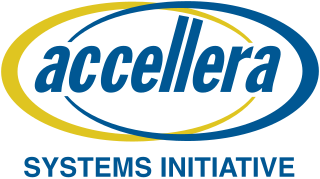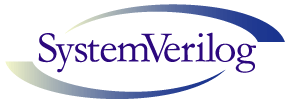The topic of this article may not meet Wikipedia's notability guidelines for products and services .(April 2021) |
OpenVera was a hardware verification language developed by System Science and acquired by Synopsys. [1]
The topic of this article may not meet Wikipedia's notability guidelines for products and services .(April 2021) |
OpenVera was a hardware verification language developed by System Science and acquired by Synopsys. [1]

The VHSIC Hardware Description Language (VHDL) is a hardware description language (HDL) that can model the behavior and structure of digital systems at multiple levels of abstraction, ranging from the system level down to that of logic gates, for design entry, documentation, and verification purposes. Since 1987, VHDL has been standardized by the Institute of Electrical and Electronics Engineers (IEEE) as IEEE Std 1076; the latest version of which is IEEE Std 1076-2019. To model analog and mixed-signal systems, an IEEE-standardized HDL based on VHDL called VHDL-AMS has been developed.
Electronic design automation (EDA), also referred to as electronic computer-aided design (ECAD), is a category of software tools for designing electronic systems such as integrated circuits and printed circuit boards. The tools work together in a design flow that chip designers use to design and analyze entire semiconductor chips. Since a modern semiconductor chip can have billions of components, EDA tools are essential for their design; this article in particular describes EDA specifically with respect to integrated circuits (ICs).

Synopsys is an American electronic design automation company that focuses on silicon design and verification, silicon intellectual property and software security and quality. Products include logic synthesis, behavioral synthesis, place and route, static timing analysis, formal verification, hardware description language simulators, and transistor-level circuit simulation. The simulators include development and debugging environments that assist in the design of the logic for chips and computer systems. In recent years, Synopsys has expanded its products and services to include application security testing. Their technology is present in self-driving cars, artificial intelligence, and internet of things consumer products.

Magma Design Automation was a software company in the electronic design automation (EDA) industry. The company was founded in 1997 and maintained headquarters in San Jose, California, with facilities throughout North America, Europe and Asia. Magma software products were used in major elements of Integrated circuit design, including: synthesis, placement, routing, power management, circuit simulation, verification and analog/mixed-signal design.

Accellera Systems Initiative (Accellera) is a standards organization that supports a mix of user and vendor standards and open interfaces development in the area of electronic design automation (EDA) and integrated circuit (IC) design and manufacturing. It is less constrained than the Institute of Electrical and Electronics Engineers (IEEE) and is therefore the starting place for many standards. Once mature and adopted by the broader community, the standards are usually transferred to the IEEE.
SystemC is a set of C++ classes and macros which provide an event-driven simulation interface. These facilities enable a designer to simulate concurrent processes, each described using plain C++ syntax. SystemC processes can communicate in a simulated real-time environment, using signals of all the datatypes offered by C++, some additional ones offered by the SystemC library, as well as user defined. In certain respects, SystemC deliberately mimics the hardware description languages VHDL and Verilog, but is more aptly described as a system-level modeling language.

SystemVerilog, standardized as IEEE 1800, is a hardware description and hardware verification language used to model, design, simulate, test and implement electronic systems. SystemVerilog is based on Verilog and some extensions, and since 2008 Verilog is now part of the same IEEE standard. It is commonly used in the semiconductor and electronic design industry as an evolution of Verilog.
Specman is an EDA tool that provides advanced automated functional verification of hardware designs. It provides an environment for working with, compiling, and debugging testbench environments written in the e Hardware Verification Language. Specman also offers automated testbench generation to boost productivity in the context of block, chip, and system verification.
Phil Moorby is a British engineer and computer scientist. Moorby was born and brought up in Birmingham, England, and studied Mathematics at Southampton University, England. Moorby received his master's degree in computer science from Manchester University, England, in 1974. He moved to the United States in 1983.
An EDA database is a database specialized for the purpose of electronic design automation. These application specific databases are required because general purpose databases have historically not provided enough performance for EDA applications.

Coverity is a proprietary static code analysis tool from Synopsys. This product enables engineers and security teams to find and fix software defects.
Atomistix ToolKit (ATK) is a commercial software for atomic-scale modeling and simulation of nanosystems. The software was originally developed by Atomistix A/S, and was later acquired by QuantumWise following the Atomistix bankruptcy. QuantumWise was then acquired by Synopsys in 2017.

Cadence Design Systems, Inc., headquartered in San Jose, California, is an American multinational computational software company, founded in 1988 by the merger of SDA Systems and ECAD, Inc. The company produces software, hardware and silicon structures for designing integrated circuits, systems on chips (SoCs) and printed circuit boards.
Unified Power Format (UPF) is the popular name of the Institute of Electrical and Electronics Engineers (IEEE) standard for specifying power intent in power optimization of electronic design automation. The IEEE 1801-2009 release of the standard was based on a donation from the Accellera organization. The current release is IEEE 1801-2018.
VHDL-AMS is a derivative of the hardware description language VHDL. It includes analog and mixed-signal extensions (AMS) in order to define the behavior of analog and mixed-signal systems.
High-level synthesis (HLS), sometimes referred to as C synthesis, electronic system-level (ESL) synthesis, algorithmic synthesis, or behavioral synthesis, is an automated design process that takes an abstract behavioral specification of a digital system and finds a register-transfer level structure that realizes the given behavior.

EVE/ZeBu is a provider of hardware-assisted verification tools for functional verification of Application-specific integrated circuits (ASICs) and system on chip (SOC) designs and for validation of embedded software ahead of implementation in silicon. EVE's hardware acceleration and hardware emulation products work in conjunction with Verilog, SystemVerilog, and VHDL-based simulators from Synopsys, Cadence Design Systems and Mentor Graphics. EVE's flagship product is ZeBu.
ARC embedded system processors are a family of 32-bit and 64-bit reduced instruction set computer (RISC) central processing units (CPUs) originally designed by ARC International.
Penny Herscher is an American executive in electronic design automation industry, formerly with Cadence Design Systems.